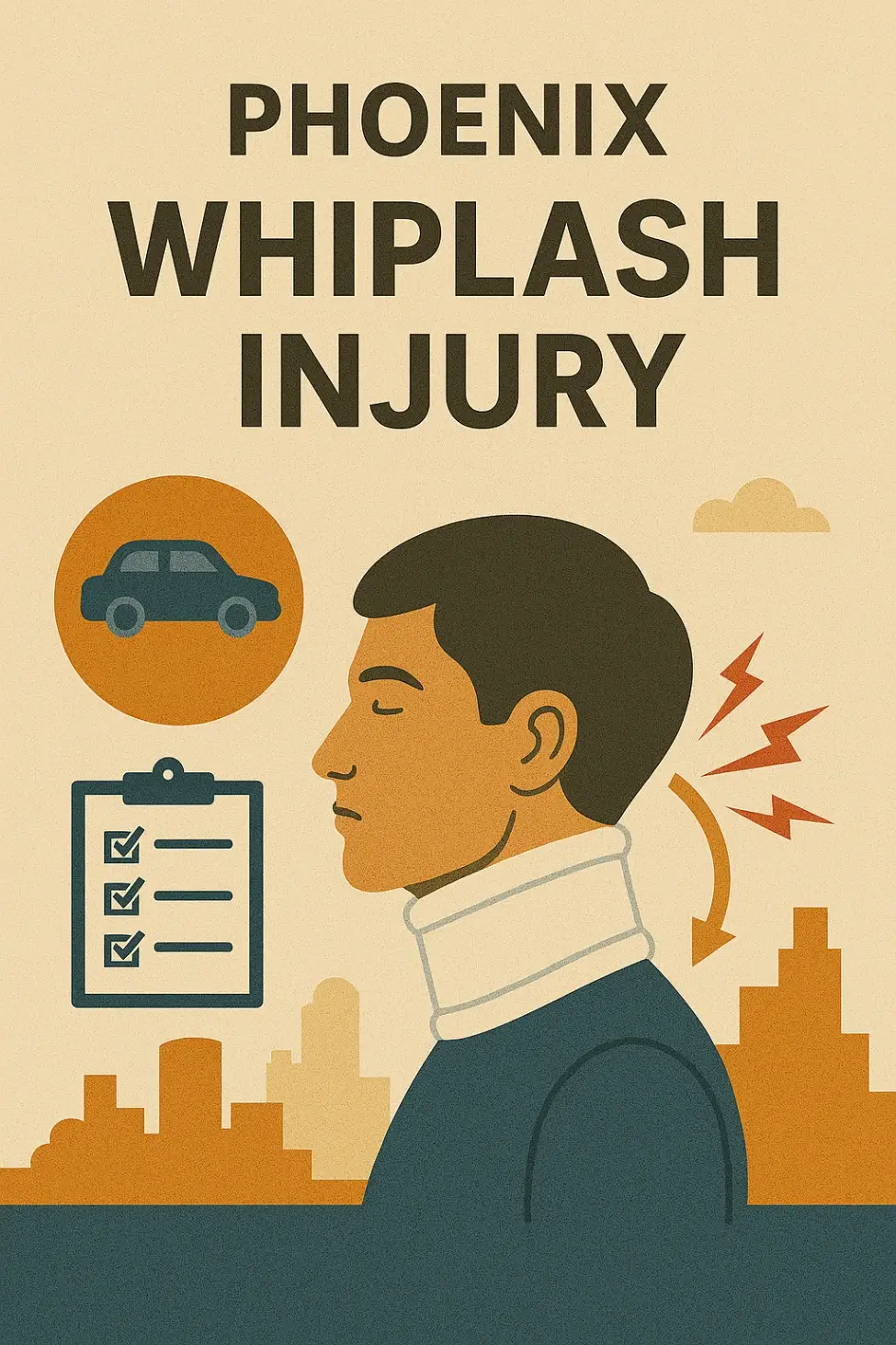Whiplash is one of the most common injuries resulting from Phoenix car accidents, yet it remains widely misunderstood and often underestimated in terms of its impact on victims’ lives. From the congested freeways of I-10 and I-17 to busy surface streets like Camelback Road and Bell Road, Phoenix’s roadways see numerous accidents daily that result in this painful and potentially debilitating condition.
What Is Whiplash and How Does It Occur?
Whiplash is a neck injury caused by a rapid back-and-forth movement of the neck, similar to the cracking of a whip. This sudden motion can damage the soft tissues (muscles, ligaments, and tendons) in the neck, creating pain and limited mobility that may persist for months or even years.
In Phoenix’s stop-and-go traffic, rear-end collisions are particularly common causes of whiplash injuries. The Arizona Department of Transportation (ADOT) reported that rear-end collisions accounted for 38% of all crashes statewide in 2023, making them the most frequent accident type in Arizona.
The physics behind whiplash are straightforward but devastating: when your vehicle is struck from behind, your body is thrust forward while your head momentarily remains in place, then snaps forward and backward in rapid succession. This violent motion exceeds the normal range of movement for the cervical spine, resulting in tears, strains, and inflammation.
Common Symptoms of Whiplash After Phoenix Car Accidents
Whiplash symptoms may not appear immediately after an accident. In fact, the Phoenix Car Accident Attorneys at GLG report that many clients don’t experience symptoms until 24-72 hours after the collision. This delayed onset can complicate both medical treatment and legal claims.
Common whiplash symptoms include:
- Neck pain and stiffness
- Headaches, typically starting at the base of the skull
- Shoulder, upper back, and arm pain
- Dizziness and fatigue
- Blurred vision
- Ringing in the ears (tinnitus)
- Difficulty concentrating and memory problems
- Sleep disturbances
- Irritability and other psychological symptoms
In more severe cases, victims may experience:
- Chronic pain lasting months or years
- Limited range of motion in the neck
- Radiating pain into the arms and hands
- Numbness or tingling in the arms
- Vertebral fractures or disc injuries
Recent Phoenix Whiplash Injury Cases
Whiplash injuries occur daily throughout the Valley, but several recent cases highlight the serious nature of these injuries:
March 2025 – Loop 101 Multi-Vehicle Collision
As reported by AZ Family, a chain-reaction crash on Loop 101 near the 7th Avenue exit involved six vehicles during morning rush hour. The incident began when a distracted driver failed to notice slowing traffic ahead. Of the 11 people evaluated by paramedics, eight reported symptoms consistent with whiplash, with three requiring hospital transport for more severe neck injuries.
April 2025 – Light Rail Collision
The Arizona Republic covered an incident where a vehicle illegally turned in front of a Valley Metro light rail train near Central Avenue and Camelback Road. Though the vehicle sustained moderate damage, the sudden stopping of the train caused several passengers to experience whiplash-type injuries. The story highlighted how even relatively low-speed impacts can cause significant neck trauma.
February 2025 – School Bus Accident
ABC15 Arizona reported a school bus accident in Chandler when a pickup truck rear-ended the bus near Arizona Avenue and Pecos Road. While none of the 34 elementary school children aboard suffered serious injuries, 12 reported neck pain and were evaluated for whiplash symptoms, demonstrating how these injuries affect Phoenix residents of all ages.
Diagnosis and Treatment of Whiplash in Phoenix
Phoenix healthcare providers employ several methods to diagnose and treat whiplash:
Diagnostic Procedures
- Physical examination and medical history
- X-rays to rule out fractures or dislocations
- CT scans for detailed bone imaging
- MRI scans to identify soft tissue injuries
- Movement and reflex tests
Treatment Approaches
- Rest and activity modification
- Ice and heat therapy
- Pain management (including prescription medications)
- Physical therapy and rehabilitation exercises
- Chiropractic care
- Massage therapy
- Acupuncture
- Injections for pain relief
- Surgical intervention in severe cases
According to the Arizona Department of Health Services, early intervention is critical for whiplash recovery. Their guidelines recommend seeking medical attention within 24 hours of any accident involving neck pain or stiffness, even if symptoms seem minor initially.
The Long-Term Impact of Whiplash Injuries
While many whiplash cases resolve within a few weeks or months, a significant percentage of victims experience chronic symptoms. The GLG Personal Injury Center notes that approximately 20-40% of whiplash victims develop chronic neck pain and related symptoms.
Long-term complications may include:
- Chronic pain syndromes
- Restricted neck mobility
- Recurring headaches
- Temporomandibular joint (TMJ) dysfunction
- Difficulty returning to work or previous activities
- Depression and anxiety related to chronic pain
- Sleep disorders
- Reduced quality of life
These ongoing issues can result in substantial medical expenses, lost income, and diminished quality of life, making proper legal representation crucial for serious whiplash cases.
Insurance Challenges with Phoenix Whiplash Claims
Whiplash claims face unique challenges with insurance companies:
Common Insurance Tactics
- Dismissing injuries as “minor” or “soft tissue only”
- Arguing that symptoms are psychosomatic or exaggerated
- Attributing symptoms to pre-existing conditions
- Offering quick, low settlements before the full extent of injuries is known
- Requiring independent medical examinations with insurance-selected doctors
- Disputing the need for ongoing treatment
The Arizona Department of Insurance provides consumer protection resources for those dealing with difficult insurance claims, including information about filing complaints when claims are improperly handled.
Legal Options for Phoenix Whiplash Victims
If you’ve suffered a whiplash injury in Phoenix due to someone else’s negligence, you have several legal avenues available:
Insurance Claims
Arizona follows a “fault” insurance system, meaning the at-fault driver’s insurance is primarily responsible for covering damages. Minimum liability requirements in Arizona are:
- $25,000 bodily injury liability per person
- $50,000 bodily injury liability per accident
- $15,000 property damage liability per accident
Personal Injury Lawsuits
When insurance coverage is insufficient or disputes arise regarding liability or damages, a personal injury lawsuit may be necessary. Arizona’s statute of limitations generally allows two years from the date of injury to file a lawsuit.
Types of Compensation Available
According to GLG’s Catastrophic Injury Guide, whiplash victims may be entitled to several types of compensation:
- Medical expenses (current and future)
- Lost wages and diminished earning capacity
- Pain and suffering
- Emotional distress
- Loss of enjoyment of life
- Household services (if you need help with daily activities)
Proving Whiplash Injuries in Phoenix Cases
Because whiplash primarily affects soft tissues and may not appear on standard imaging, proving these injuries can be challenging. Effective documentation is crucial:
Medical Documentation
- Seek treatment promptly after an accident
- Follow all treatment recommendations consistently
- Maintain detailed records of all medical visits and treatments
- Document how symptoms affect daily activities
- Keep a pain journal tracking symptoms and limitations
Expert Testimony
In more complex cases, testimony from medical experts may be necessary to establish:
- The connection between the accident and your injuries
- The expected duration and severity of symptoms
- Future treatment needs and associated costs
- Impact on work capacity and quality of life
Preventing Whiplash in Phoenix Traffic
While not all accidents can be prevented, several measures can reduce your risk of whiplash:
- Adjust your headrest properly (top of the headrest should align with the top of your ears)
- Maintain a safe following distance in traffic
- Stay alert to traffic conditions ahead, particularly on congested Phoenix freeways
- Avoid distracted driving
- Strengthen neck muscles through regular exercise
- Consider vehicle safety ratings when purchasing a car, focusing on models with good whiplash protection systems
Resources for Phoenix Whiplash Victims
Several resources are available to assist whiplash victims in Phoenix:
- Arizona Department of Transportation – For accident statistics and safety information
- Maricopa Integrated Health System – Offers specialized trauma and rehabilitation services
- Arizona Association of Chiropractic – Provides information about chiropractic treatment options
Steps to Take After Suffering Whiplash in Phoenix
If you believe you’ve sustained a whiplash injury in a Phoenix accident:
- Seek immediate medical attention – Even if symptoms seem minor initially
- Document everything – Take photos of the accident scene and your injuries
- Report the accident – File a police report and notify your insurance company
- Follow all treatment recommendations – Consistency in treatment strengthens both your recovery and your claim
- Track your symptoms – Keep a journal of pain levels, limitations, and how the injury affects your daily life
- Preserve evidence – Keep all medical records, accident reports, and communication with insurance companies
- Consult with an attorney – Especially if your symptoms persist or if the insurance company disputes your claim
Conclusion
Whiplash injuries represent a common but potentially serious consequence of Phoenix-area accidents. Despite being dismissed by some as minor injuries, the reality is that whiplash can lead to chronic pain, disability, and significant financial and emotional costs for victims.
By understanding the causes, symptoms, treatment options, and legal considerations related to whiplash, Phoenix residents can better protect their health and legal rights following an accident. If you’ve suffered a whiplash injury due to someone else’s negligence, consulting with medical professionals and experienced legal representation can help ensure you receive proper treatment and fair compensation for your injuries.
References
- Arizona Department of Transportation. (2023). Arizona Motor Vehicle Crash Facts.
- Arizona Department of Health Services. (2024). Injury Prevention Guidelines.
- Arizona Department of Insurance. (2025). Consumer Insurance Resources.
- AZ Family. (March 2025). Multi-vehicle crash on Loop 101 results in multiple whiplash injuries.
- Arizona Republic. (April 2025). Light rail collision highlights dangers of illegal turns and passenger injuries.
- ABC15 Arizona. (February 2025). School bus rear-ended in Chandler, students evaluated for neck injuries.



